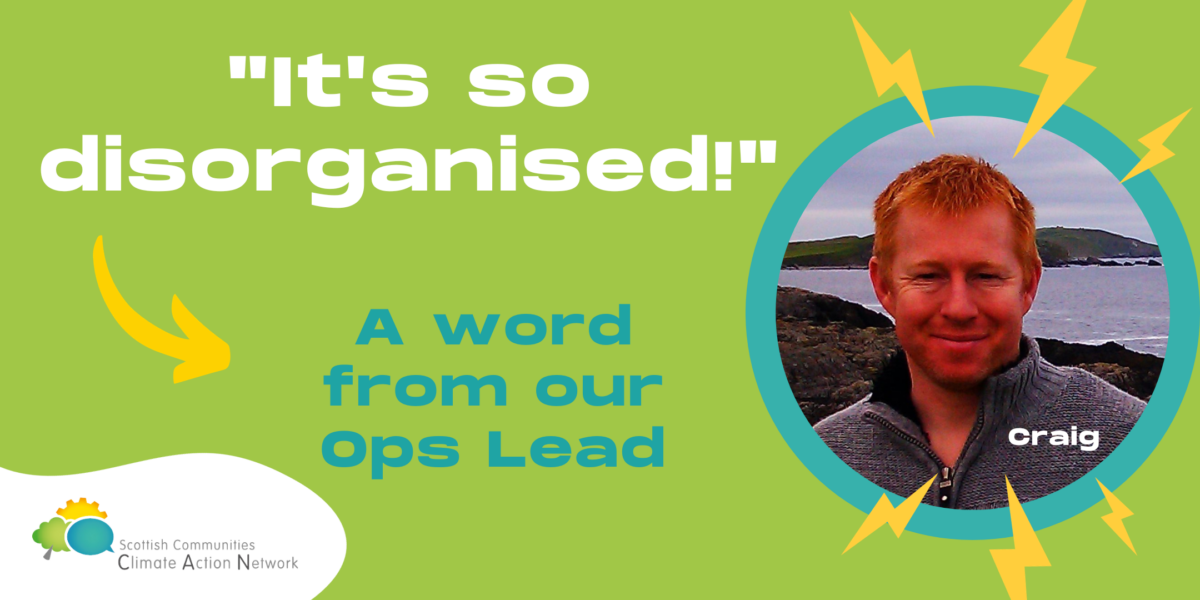
“It’s so disorganised!” claimed a friend in a recent conversation about the plethora of organisations working locally to combat the climate crisis.
A conversation that sprung out of praise for a local e-bike partnership where a social enterprise worked with the local council to provide e-bike hire to visitors and local residents.
Cutting traffic numbers, increasing health and wellbeing and providing a cleaner environment, is how I saw it. The conversation started convivially then got a bit more spikey when it was mentioned that an organisation with a geographical reach that overlapped this enterprise was already performing this role. The tone went stratospheric, in a way only friends who respect each other can go stratospheric without falling out, when it was further intimated that the team leading the project didn’t think they were working to help combat the climate crisis.
I have no way of knowing if this is true or not, but it was proposed that the team simply wanted to run a bike business. Any environmental benefit was secondary.
Which led, over a few drinks (my friends home-made cider was particularly potent, so potent that we decided that the only appropriate brand name for it was “Amnesia”), to a deep discussion about two things.
- Is our (the movements) response to the Climate Crisis disorganised?
- Is that a good thing?
Now, I’m not going to delve into the dark recesses of our alcohol-induced prophecies and uneducated insights as the evening progressed. But a few days later these two questions popped back into my head.*
Firstly, in my experience, at a local level, people respond to the need they see. They don’t respond to top down instructions very well. So a local response in one area can look completely different to a local response in another area. This is dependent on the people who respond, what they see as priority, how stacked up their willpower is, and sometimes, who shouts the loudest. Plus a few other influences thrown into the mix.
So looking downwards from on high, as my friend was doing, it can look disorganised. Different areas with different focuses, bumping up projects that have vastly different outcomes.
If you take the doughnut economy model then there are twelve inner social foundations. Not every community has the capacity to work on twelve at the same time. So different communities will naturally be working on what rings their particular bells at that particular moment.
At another level organisations may compete for the same funding. Indeed I have witnessed many occassions where organisations have competed against each other for funding in the same field. One could argue that this level could be rationalised and better organised, with the merging of some projects. But doesn’t that take their connection from the local grass roots away?
Also, isn’t overlap much better than underlap? I guess that depends on the angle you approach from. If you’re coming from a funding viewpoint it’s probably not a good thing. If you view it through coverage tinted specs then it’s probably a positive.
Secondly, (dark recess warning = on) we live in a country that has intense surveillance. A political system that does not serve the needs of the people and an economic model that, if left unchecked, will likely be the end of us all. Where our environment is dying and where the response of our “rulers” falls so pathetically short that a large percentage of the population is almost paralysed by anxiety.
Any response through normal means is not causing the systematic change needed. Although, let’s not be to hard no ourselves. In Scotland we’re doing a bit better than some, and in some cases leading the way internationally. But it’s still not what is needed from up the chain.
With a distributed model, creating communities of practice, who respond to the local needs at a local level we remove ourselves somewhat from the system that is failing us. By creating local circular economies, or by removing certain services from the need for centralised funding, encouraging non-monetised services and altruistic values, then the current system starts to become obsolete, at a local level.
Daily I read the updates from Transition Together’s Vive platform (if you haven’t registered then you should, it’s a fillip each day), and every day I’m encouraged and motivated by the amazing work people are doing to save and serve our communities and protect or enhance our environment. There is a huge number of people out there doing great stuff.
I mean, some need help. Some on communicating with other groups, finding solutions that are already tested, governance, finance, legal, comms etc. Some just want a shoulder to cry on when things aren’t going well. And there’s lots of resources out there. We just need to make sure everyone knows where to go to get them. My hope is that SCCAN, with the network hubs now set up, can fulfil a role where we provide or point people to these resources and help communities adapt to the changes already happening.
One could argue if that grass roots work was organised centrally then it would be easier to control (by definition not “grass roots”) and also easier to stop. In my opinion this “disorganisation” makes it more resilient, like an internet of climate action, less likely to be halted by nefarious people. Break one part and another pops up and takes action.
The variety and effort and accomplishments of our movement should be celebrated. There are hugely motivating and special stories that need told. It may be that this “disorganised” model is the only way we can make change happen. I have a feeling in centuries to come it will become the story of all stories. How communities took back control and with their various colours, beliefs, backgrounds, skills and efforts, made the changes necessary to save our planet.
*the observant of you will notice that the brand name needs a rethink.

